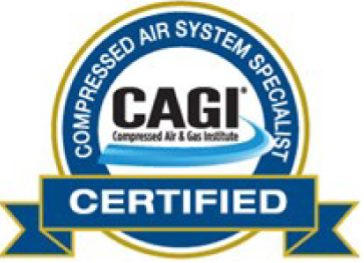
By Ron Marshall
You may have noticed some email signatures displaying the Certified CCASS symbol — and have become curious as to how that’s earned. Anyone, if properly prepared, can become certified by writing and passing an exam. The ease in preparing for the CAGI (Compressed Air and Gas Institute) Certified Compressed Air System Specialist certification can be enhanced significantly by incorporating the resources offered by the Compressed Air Challenge. Here is some advice if you are interested in achieving this level of recognition:
- Understand the certification requirements: Start by thoroughly reviewing the requirements for the CAGI certification, which includes educational prerequisites, relevant work experience, and knowledge areas covered in the certification exam. You will notice a great online basic preparation course on the CAGI website.
- Educational background: Ensure your educational background aligns with the requirements. Typically, a degree in mechanical engineering, industrial engineering, or a related field is advantageous — but not totally necessary.
- Gain practical experience: Work in roles related to compressed air systems, such as engineering, maintenance, sales, or service. Practical experience is crucial for understanding the complexities of these systems.
- Basic knowledge of compressed air systems: Build a strong foundation in the basics of compressed air systems. This includes understanding air compressors, air treatment, distribution systems, energy efficiency, and control systems.
- Use Compressed Air Challenge resources: The Compressed Air Challenge offers a wealth of resources that are invaluable for preparation. Their educational materials, seminars, and workshops are specifically tailored to cover all aspects of compressed air systems, providing both fundamental and advanced knowledge.
- Take CAGI and Compressed Air Challenge training: Engage in training programs offered by both CAGI and the Compressed Air Challenge. These programs are designed to cover the curriculum necessary for the certification and also offer practical, real-world insights.
- Networking: Connect with industry professionals, including those who have taken the Compressed Air Challenge training or are CAGI certified. Networking can offer practical advice and insights into the certification process.
- Dedicated study for the exam: Allocate time for focused study. This should include a thorough review of technical manuals, standards, Compressed Air Challenge materials, and any practice exams available.
- Apply for the certification exam: Once prepared, apply to take the certification exam. Ensure you meet all eligibility criteria. Currently the exam registration fee is at a special lower price.
- Continuing education: After achieving certification, engage in ongoing learning to maintain and expand your knowledge. This includes participating in Compressed Air Challenge events and other educational opportunities for recertification requirements.
Remember, the combination of theoretical knowledge and practical experience, enriched by the comprehensive materials provided by the Compressed Air Challenge, will be key to your success in becoming a CAGI Certified Compressed Air System Specialist.
Filed Under: Components Oil Coolers, Compressed Air Technologies, Pneumatic Tips, Technologies